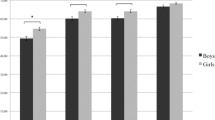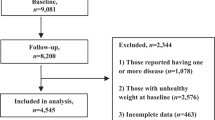Abstract
Objective: To compare the diet history (DH) method to an estimated 7-day record (7-d) concerning meal pattern and intake of foods, energy and nutrients.
Design: After the DH interview, subjects completed the 7-d.
Setting: School setting, Göteborg, Sweden.
Subjects: A total of 51 adolescent girls (15–16 y) recruited from 634 girls participating in The Göteborg Adolescence Study.
Results: Two-thirds of the girls had identical or similar main meal pattern, while the number of in-between meals was higher using DH (P<0.001). Breakfast was the meal that agreed best and dinner during weekends. Energy intake (EI) was 8% higher in DH compared to 7-d (P=0.056). The ratio EI to basal metabolic rate was 1.35 (1.14, 1.65) using DH and 1.26 (1.08, 1.52) using 7-d, indicating under-reporting in both methods. Intake of vegetables, juice, sweets, soft-drinks and jam did not differ between the methods, but for the rest of the intake DH estimates were higher (P<0.05). The calculated nutrient intake was higher by DH, with exception of fat and sucrose. For the main food groups, energy and nutrients, except alcohol, ranking was similar between the methods. Adjusted for EI (10 MJ), intake of fat and sucrose were lower and protein, calcium and fibre were higher by DH (P<0.01). EI did not differ for lunch and dinner, but was higher in breakfast and in-between meals using DH. Intake of foods and nutrients in lunches and meat and fish for lunch and dinner did not differ.
Conclusions: The diet history seems to work well as a reference method for dietary assessments in this age group.
Sponsorship: The Swedish Medical Research Council (project B94-19X-04721-19A), the Swedish Mill Industry, The Wilhelm and Martina Lundgren Foundation and The Swedish Nutrition Foundation.
This is a preview of subscription content, access via your institution
Access options
Subscribe to this journal
Receive 12 print issues and online access
$259.00 per year
only $21.58 per issue
Buy this article
- Purchase on Springer Link
- Instant access to full article PDF
Prices may be subject to local taxes which are calculated during checkout

Similar content being viewed by others
References
Andersen LF, Nes M, Lillegaard IT, Sandstad B, Bjørneboe GE & Drevon CA (1995): Evaluation of a quantitative food frequency questionnaire used in a group of Norwegian adolescents. Eur. J. Clin. Nutr. 49, 543–554.
Bandini LG, Schoeller DA, Cyr HN & Dietz WH (1990): Validity of reported energy intake in obese and nonobese adolescents. Am. J. Clin. Nutr. 52, 421–425.
Beaton GH, Milner J, Corey P, McGuire V, Cousins M, Stewart E, de Ramos M, Hewitt D, Grambsch PV, Kassim N & Little JA (1979): Sources of variance in 24-hour dietary recall data: implications for nutrition study design and interpretation. Am. J. Clin. Nutr. 32, 2546–2549.
Berg-Kelly K (1995): Normative developmental behavior with implications for health and health promotion among adolescents: a Swedish cross-sectional survey. Acta Paediatr. 84, 278–288.
Bergström E, Hernell O & Persson L (1993): Dietary changes in Swedish adolescents. Acta Paediatr. 82, 472–480.
Bingham SA (1994): The use of 24-h urine samples and energy expenditure to validate dietary assessments. Am. J. Clin. Nutr. 59, 227S–231S.
Bingham SA, Gill C, Welch A, Day K, Cassidy A, Khaw KT, Sneyd MJ, Key TJ, Roe L & Day NE (1994): Comparison of dietary assessment methods in nutritional epidemiology: weighed records v. 24 h recalls, food-frequency questionnaires and estimated-diet records. Br. J. Nutr. 72, 619–643.
Bland JM & Altman DG (1986): Statistical methods for assessing agreement between two methods of clinical measurement. Lancet 1, 307–310.
Bratteby LE, Sandhagen B, Fan H, Enghardt H & Samuelson G (1998): Total energy expenditure and physical activity as assessed by the doubly labeled water method in Swedish adolescents in whom energy intake was underestimated by 7-d diet records. Am. J. Clin. Nutr. 67, 905–911.
Elmén H, Höglund D, Niklasson A & Nilsson W (1995): Birth weight for gestational age and sex as a health indicator at local area level. Int. J. Health Sci. 6, 117–126.
FAO/WHO/UNU (1985): Energy and protein requirements. Report of a Joint FAO/WHO/UNU consultation. Technical report series 724. Geneva: World Health Organization.
Goldberg GR, Black AE, Jebb SA, Cole TJ, Murgatroyd PR, Coward WA & Prentice AM (1991): Critical evaluation of energy intake data using fundamental principles of energy physiology: 1. Derivation of cut-off limits to identify under- recording. Eur. J. Clin. Nutr. 45, 569–581.
Goris AH & Westerterp KR (1999): Underreporting of habitual food intake is explained by undereating in highly motivated lean women. J. Nutr. 129, 878–882.
Hallberg L & Hulthen L (2000): Prediction of dietary iron absorption: an algorithm for calculating absorption and bioavailability of dietary iron. Am. J. Clin. Nutr. 71, 1147–1160.
Hartman AM, Brown CC, Palmgren J, Pietinen P, Verkasalo M, Myer D & Virtamo J (1990): Variability in nutrient and food intakes among older middle-aged men. Implications for design of epidemiologic and validation studies using food recording. Am. J. Epidemiol. 132, 999–1012.
Heath AL, Skeaff CM & Gibson RS (2000): The relative validity of a computerized food frequency questionnaire for estimating intake of dietary iron and its absorption modifiers. Eur. J. Clin. Nutr. 54, 592–599.
Hedgren M, Arvidsson Lenner R & Samuelson G (1995): A dietary survey in adolescents. Methodological aspects of 7-day food record. Scand. J. Nutr./Näringsforskning 39, 60–65.
Höglund D, Samuelson G & Mark A (1998): Food habits in Swedish adolescents in relation to socioeconomic conditions. Eur. J. Clin. Nutr. 52, 784–789.
Høidrup S, Andreasen AH, Osler M, Pedersen AN, Jørgensen LM, Jørgensen T, Schroll M & Heitmann BL (2002): Assessment of habitual energy and macronutrient intake in adults: comparison of a seven day food record with a dietary history interview. Eur. J. Clin. Nutr. 56, 105–113.
Hulthén L, Hallberg L, Albertsson-Wikland K, Bondestam M, Ekblom B, Höglund D, Lindstedt G, Sjöberg A & Slinde F (2003): Height and weight in two representative samples of Swedish adolescents, in manuscript.
Jain M, Howe GR & Rohan T (1996): Dietary assessment in epidemiology: comparison on food frequency and a diet history questionnaire with a 7-day food record. Am. J. Epidemiol. 143, 953–960.
Jenkins DJ, Wolever TM, Collier GR, Ocana A, Rao AV, Buckley G, Lam Y, Mayer A & Thompson LU (1987): Metabolic effects of a low-glycemic-index diet. Am. J. Clin. Nutr. 46, 968–975.
Livingstone MB & Black AE (2003): Markers of the validity of reported energy intake. J. Nutr. 133(Suppl 3), 895S–920S.
Livingstone MB, Prentice AM, Coward WA, Strain JJ, Black AE, Davies PS, Stewart CM, McKenna PG & Whitehead RG (1992): Validation of estimates of energy intake by weighed dietary record and diet history in children and adolescents. Am. J. Clin. Nutr. 56, 29–35.
Livingstone MB & Robson PJ (2000): Measurement of dietary intake in children. Proc. Nutr. Soc. 59, 279–293.
Mensink GB, Haftenberger M & Thamm M (2001): Validity of DISHES 98, a computerised dietary history interview: energy and macronutrient intake. Eur. J. Clin. Nutr. 55, 409–417.
Nelson M & Bingham SA (1998): Assessment of food consumption and nutrient intake, In Design Concepts in Nutritional Epidemiology. eds M.B.M. & N.M., pp 123–169. Oxford: Oxford University Press.
Nelson M, Black AE, Morris JA & Cole TJ (1989): Between- and within-subject variation in nutrient intake from infancy to old age: estimating the number of days required to rank dietary intakes with desired precision. Am. J. Clin. Nutr. 50, 155–167.
Price GM, Paul AA, Cole TJ & Wadsworth ME (1997): Characteristics of the low-energy reporters in a longitudinal national dietary survey. Br. J. Nutr. 77, 833–851.
Ruxton CH & Kirk TR (1997): Breakfast: a review of associations with measures of dietary intake, physiology and biochemistry. Br. J. Nutr. 78, 199–213.
Samuelson G, Bratteby LE, Enghardt H & Hedgren M (1996): Food habits and energy and nutrient intake in Swedish adolescents approaching the year 2000. Acta Paediatr. Suppl. 415, 1–19.
Schofield WN (1985): Predicting basal metabolic rate, new standards and review of previous work. Hum. Nutr. Clin. Nutr. 39, 5–41.
Sjöberg A, Hallberg L, Höglund D & Hulthén L (2003a): Meal pattern, food choice, nutrient intake and lifestyle factors in The Göteborg Adolescence Study. Eur. J. Clin. Nutr. 57, 1569–1578.
Sjöberg A, Slinde F, Arvidsson D, Ellegård L, Gramatkovski E, Hallberg L & Hulthén L (2003b): Energy intake in Swedish adolescents: validation of diet history with doubly labelled water. Eur. J. Clin. Nutr. 57, 1643–1652.
Swedish National Food Administration (1994): The Food Composition Table—Energy and Nutrients. Uppsala, Sweden: Swedish National Food Administration.
Worsley A, Baghurst KI & Leitch DR (1984): Social desirability response bias and dietary inventory responses. Hum. Nutr. Appl. Nutr. 38, 29–35.
Acknowledgements
We thank the dieticians Ewa Silander and Gabriele Eiben for performing the dietary assessments.
Author information
Authors and Affiliations
Contributions
Guarantor: L Hulthén.
Contributors: Both investigators designed the study, interpreted results and wrote the paper. L Hulthén was responsible for the running of The Göteborg Adolescence Study and A Sjöberg was responsible for the dietary data and statistical analysis.
Corresponding author
Rights and permissions
About this article
Cite this article
Sjöberg, A., Hulthén, L. Assessment of habitual meal pattern and intake of foods, energy and nutrients in Swedish adolescent girls: comparison of diet history with 7-day record. Eur J Clin Nutr 58, 1181–1189 (2004). https://doi.org/10.1038/sj.ejcn.1601947
Received:
Revised:
Accepted:
Published:
Issue Date:
DOI: https://doi.org/10.1038/sj.ejcn.1601947
Keywords
This article is cited by
-
Comparison of food consumption and nutrient intake assessed with three dietary assessment methods: results of the German National Nutrition Survey II
European Journal of Nutrition (2019)
-
Comparison of meal patterns across five European countries using standardized 24-h recall (GloboDiet) data from the EFCOVAL project
European Journal of Nutrition (2018)
-
Comparison of food habits, iron intake and iron status in adolescents before and after the withdrawal of the general iron fortification in Sweden
European Journal of Clinical Nutrition (2015)
-
Comparison of two dietary assessment methods by food consumption: results of the German National Nutrition Survey II
European Journal of Nutrition (2015)
-
Main meal frequency measures in the Health Behaviour in School-aged Children study: agreement with 7-day 24-h recalls
International Journal of Public Health (2015)



